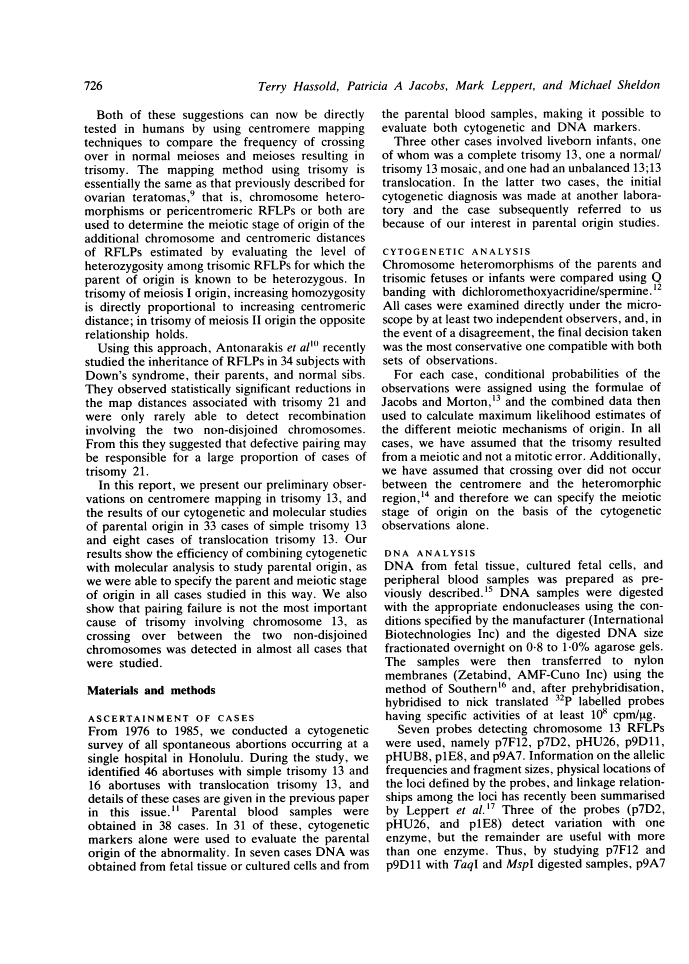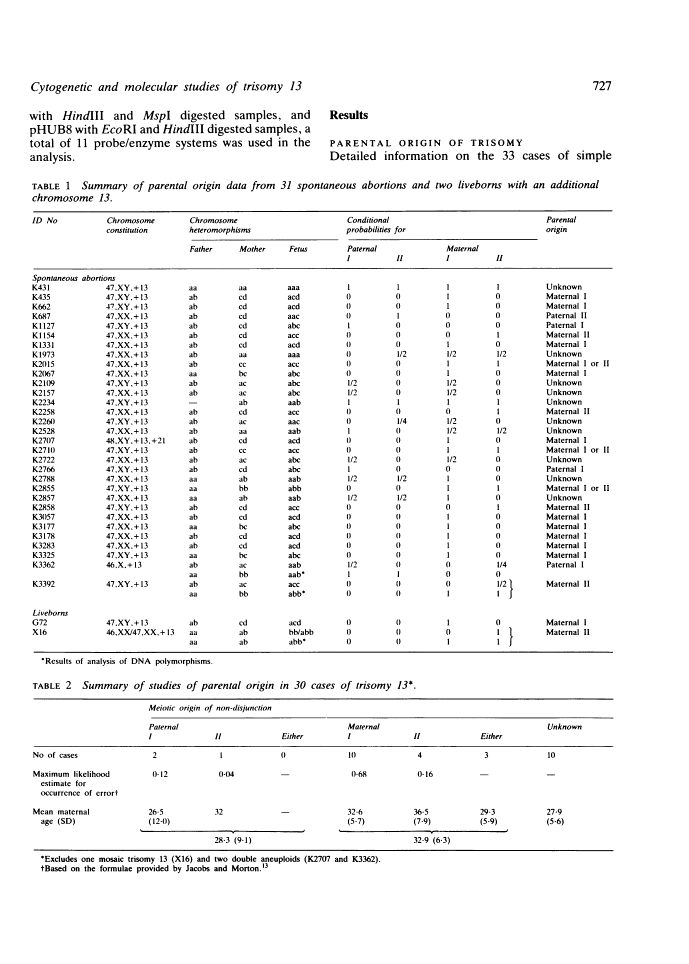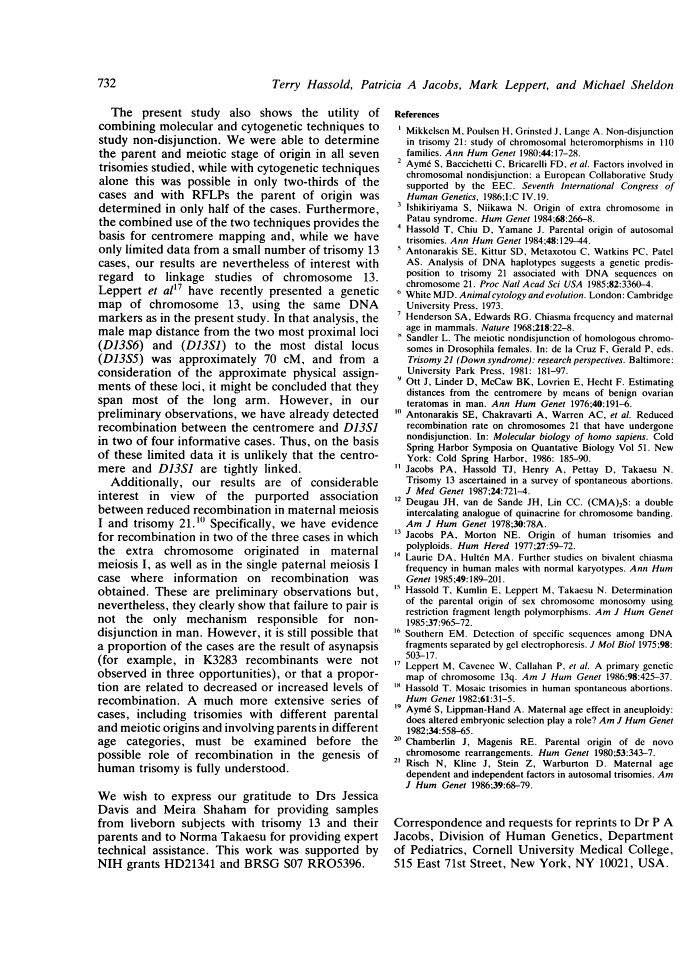Abstract
Free full text

Cytogenetic and molecular studies of trisomy 13.
Abstract
Chromosome heteromorphisms, restriction fragment length polymorphisms, or both were used to study the parental origin of 33 cases of simple trisomy 13 and eight cases of translocation trisomy 13. The most common origin for the simple trisomies was non-disjunction at maternal meiosis I, while for the translocations an equal number of paternally and maternally derived cases was observed. In seven of the simple trisomies, information was obtained from both the cytogenetic and molecular markers, making it possible to study recombination between the two non-disjoined chromosomes. Five of the seven cases involved errors at meiosis I, with crossing over being detected in two of three cases of maternal origin and in one of two cases of paternal origin. This indicates that absence of recombination because of pairing failure is unlikely to be of major importance in the genesis of trisomy 13.
Full text
Full text is available as a scanned copy of the original print version. Get a printable copy (PDF file) of the complete article (1.3M), or click on a page image below to browse page by page. Links to PubMed are also available for Selected References.
Images in this article
Selected References
These references are in PubMed. This may not be the complete list of references from this article.
- Mikkelsen M, Poulsen H, Grinsted J, Lange A. Non-disjunction in trisomy 21: study of chromosomal heteromorphisms in 110 families. Ann Hum Genet. 1980 Jul;44(Pt 1):17–28. [Abstract] [Google Scholar]
- Ishikiriyama S, Niikawa N. Origin of extra chromosome in Patau syndrome. Hum Genet. 1984;68(3):266–268. [Abstract] [Google Scholar]
- Hassold T, Chiu D, Yamane JA. Parental origin of autosomal trisomies. Ann Hum Genet. 1984 May;48(Pt 2):129–144. [Abstract] [Google Scholar]
- Antonarakis SE, Kittur SD, Metaxotou C, Watkins PC, Patel AS. Analysis of DNA haplotypes suggests a genetic predisposition to trisomy 21 associated with DNA sequences on chromosome 21. Proc Natl Acad Sci U S A. 1985 May;82(10):3360–3364. [Europe PMC free article] [Abstract] [Google Scholar]
- Henderson SA, Edwards RG. Chiasma frequency and maternal age in mammals. Nature. 1968 Apr 6;218(5136):22–28. [Abstract] [Google Scholar]
- Ott J, Linder D, McCaw BK, Lovrien EW, Hecht F. Estimating distances from the centromere by means of benign ovarian teratomas in man. Ann Hum Genet. 1976 Nov;40(2):191–196. [Abstract] [Google Scholar]
- Antonarakis SE, Chakravarti A, Warren AC, Slaugenhaupt SA, Wong C, Halloran SL, Metaxotou C. Reduced recombination rate on chromosomes 21 that have undergone nondisjunction. Cold Spring Harb Symp Quant Biol. 1986;51(Pt 1):185–190. [Abstract] [Google Scholar]
- Jacobs PA, Hassold TJ, Henry A, Pettay D, Takaesu N. Trisomy 13 ascertained in a survey of spontaneous abortions. J Med Genet. 1987 Dec;24(12):721–724. [Europe PMC free article] [Abstract] [Google Scholar]
- Jacobs PA, Morton NE. Origin of human trisomics and polyploids. Hum Hered. 1977;27(1):59–72. [Abstract] [Google Scholar]
- Laurie DA, Hultén MA. Further studies on bivalent chiasma frequency in human males with normal karyotypes. Ann Hum Genet. 1985 Jul;49(Pt 3):189–201. [Abstract] [Google Scholar]
- Hassold T, Kumlin E, Takaesu N, Leppert M. Determination of the parental origin of sex-chromosome monosomy using restriction fragment length polymorphisms. Am J Hum Genet. 1985 Sep;37(5):965–972. [Europe PMC free article] [Abstract] [Google Scholar]
- Southern EM. Detection of specific sequences among DNA fragments separated by gel electrophoresis. J Mol Biol. 1975 Nov 5;98(3):503–517. [Abstract] [Google Scholar]
- Leppert M, Cavenee W, Callahan P, Holm T, O'Connell P, Thompson K, Lathrop GM, Lalouel JM, White R. A primary genetic map of chromosome 13q. Am J Hum Genet. 1986 Oct;39(4):425–437. [Europe PMC free article] [Abstract] [Google Scholar]
- Aymé S, Lippman-Hand A. Maternal-age effect in aneuploidy: does altered embryonic selection play a role? Am J Hum Genet. 1982 Jul;34(4):558–565. [Europe PMC free article] [Abstract] [Google Scholar]
- Chamberlin J, Magenis RE. Parental origin of de novo chromosome rearrangements. Hum Genet. 1980;53(3):343–347. [Abstract] [Google Scholar]
- Risch N, Stein Z, Kline J, Warburton D. The relationship between maternal age and chromosome size in autosomal trisomy. Am J Hum Genet. 1986 Jul;39(1):68–78. [Europe PMC free article] [Abstract] [Google Scholar]
Associated Data
Articles from Journal of Medical Genetics are provided here courtesy of BMJ Publishing Group
Full text links
Read article at publisher's site: https://doi.org/10.1136/jmg.24.12.725
Read article for free, from open access legal sources, via Unpaywall:
https://jmg.bmj.com/content/24/12/725.full.pdf
Free to read at jmg.bmjjournals.com
http://jmg.bmjjournals.com/cgi/content/abstract/24/12/725
Citations & impact
Impact metrics
Citations of article over time
Article citations
Identification and characterization of Aurora kinase B and C variants associated with maternal aneuploidy.
Mol Hum Reprod, 23(6):406-416, 01 Jun 2017
Cited by: 19 articles | PMID: 28369513 | PMCID: PMC9915067
1(st) trimester miscarriage: four decades of study.
Transl Pediatr, 4(2):189-200, 01 Apr 2015
Cited by: 27 articles | PMID: 26835373 | PMCID: PMC4729087
Review Free full text in Europe PMC
The root of reduced fertility in aged women and possible therapentic options: current status and future perspects.
Mol Aspects Med, 38:54-85, 21 Jun 2013
Cited by: 73 articles | PMID: 23796757
Review
[Preimplantation diagnosis--PID: preimplantation genetic diagnosis (PGD) and preimplantation genetic screening (PGS)].
Bundesgesundheitsblatt Gesundheitsforschung Gesundheitsschutz, 56(12):1670-1678, 01 Dec 2013
Cited by: 0 articles | PMID: 24337129
Meiotic origins of maternal age-related aneuploidy.
Biol Reprod, 86(1):1-7, 10 Jan 2012
Cited by: 104 articles | PMID: 21957193 | PMCID: PMC3313661
Review Free full text in Europe PMC
Go to all (40) article citations
Similar Articles
To arrive at the top five similar articles we use a word-weighted algorithm to compare words from the Title and Abstract of each citation.
Non-disjunction of chromosome 13.
Hum Mol Genet, 16(16):2004-2010, 21 Jun 2007
Cited by: 23 articles | PMID: 17584770
Nondisjunction of chromosome 21.
Am J Med Genet Suppl, 7:175-181, 01 Jan 1990
Cited by: 9 articles | PMID: 1981476
Origin and mechanisms of non-disjunction in human autosomal trisomies.
Hum Reprod, 13(2):313-319, 01 Feb 1998
Cited by: 118 articles | PMID: 9557829
Review
Trisomy 21 (Down syndrome): studying nondisjunction and meiotic recombination by using cytogenetic and molecular polymorphisms that span chromosome 21.
Am J Hum Genet, 42(2):227-236, 01 Feb 1988
Cited by: 22 articles | PMID: 2893544 | PMCID: PMC1715248
Funding
Funders who supported this work.
NCRR NIH HHS (1)
Grant ID: S07 RR05396
NICHD NIH HHS (1)
Grant ID: HD21341













